The Story Of One Of The 91st SRS COs,
|
||||||||||||||||
| When we left the states in November of 1943, we were told we would be back on March 15th of 1944. We buzzed MacDill in formation on March 15th, right on schedule. We lost one airplane but no crew members on the way home. Going in for a landing at a very high altitude field in Ethiopia, the pilot cut his power too much on approach and was unable get that power when he saw he was overshooting the runway. He belly landed in the rocky area alongside the runway. No one was hurt. We parceled the cameras, crew and equipment aboard the other nine planes and continued on home. |
||||||||||||||||
| After our arrival we were told that the squadron was moving from MacDill Field to Smoky Hill Army Air Field, Salina, KS, Dottie’s home town, and would be converting to the B-29 Photo Reconnaissance plane that was yet to be manufactured. We turned in our F-10s to Will Rogers Field at Oklahoma City, our B-24s to the depot at Mobile, AL and proceeded to Bradley Field, CT to check out in F-9s (the B-17 photo version). We then took the F-9s to Smoky Hill. Meanwhile, the wives of the married officers and NCOs packed their few belongings into their cars and made the long drive from Tampa to Salina. On arrival, we all found that housing was at a premium in Salina. Dottie and I felt lucky to find a one room apartment that left much to be desired. Some of our married officers commuted from small towns nearby like Lindsborg. |
||||||||||||||||
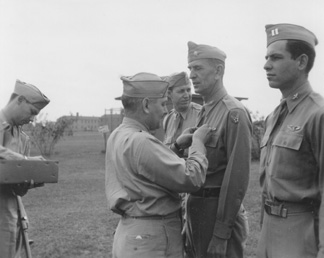 |
||||||||||||||||
|
soon after March 15, 1944. Col “Pappy” Northrup came down to MacDill from his Bolling Field, D. C. Hq. Maj. Pat McCarthy and Capt. Clarence Becker were awarded DFCs. Clarence Becker’s award was for planning and execution of the mass mosaic over enemy territory (Burma) in unarmed F-10s that made a significant contribution to success of the Imphal invasion. |
||||||||||||||||
|
Editors Note: The reconnassiance version of the B-29 was known as the F-13. If you would like to review a selection of 8 photographs of the F-13 camera configurations, you may click here and then return to this page through use of your back button or an easy return link. |
||||||||||||||||
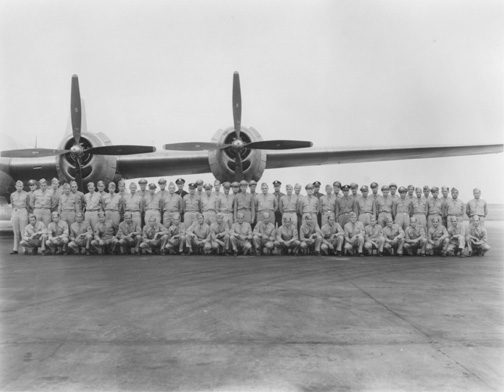 |
||||||||||||||||
|
An attempt to photograph all flight crews in the squadron, an almost impossible task with the sheer amount of training going on at the time. |
||||||||||||||||
| We did our phase training in the F-9s. The squadron grew in size with gunners, electronic technicians and corresponding increase in armament, radar, etc. We were to train 16 F-13 crews with 4 of them slated to go to the CBI and 12 to the Pacific. Our ground echelon left Smoky Hill by train to the west Coast and then by boat to Saipan in late summer. Our first F-13 arrived in August. There was an engine overheating problem with the first few planes delivered to us. To minimize the problem, after pre-flighting the plane at the apron parking area, we would tow the plane to the end of the runway, make a very rapid start and take off immediately. |
||||||||||||||||
| Usually, by the time we were airborne, all four engine cylinder head temperatures were in the red danger zone and we were faced with the enigma. Back off on the power to all engines to cool them down while skimming along at low altitude just above the wheatfields, or leave the power on and climb to a working altitude, damn the cylinder head temperatures. The latter procedure proved the wisest option. The problem was solved with our succeeding aircraft delivered with a nacelle modification that changed the airflow over the cylinders. A maintenance Sergeant at the Tinker Oklahoma Depot was responsible for solving that serious problem. Our new F-13As were delivered to Herington Field, not far from Salina. So when we were ready to depart for the Pacific,, we were bussed over to Herington, checked out our planes and departed. I had been fortunate to find a cracker box new home to rent and move Dottie into just before we left. She was 6 months pregnant when I left with my flight of 4 from Herrington. We left the states from Mather Field, CA, then on to Honolulu, Kwajalein into Isely Field on Saipan. I crossed the International date line on the leg from Kwajalein to Saipan thus missing my birthday of November 18th, leaving on the 17th and landing on the 19th. Our ground echelon had arrived earlier and we were quartered in tents. Captain Doug Steakley’s flight had arrived in late October and had flown several missions getting photos of the targets that the B-29s were about to attack. His flight in ‘Tokyo Rose” on November 1st was the first airplane over Tokyo since Jimmy Doolittle’s token B-25 raid from an aircraft carrier in 1942. |
||||||||||||||||
| Some 17 reconnaissance missions were flown as single sorties prior to the first B-29 bombing raid against Japan from Saipan on November 24th, 1944. Capt. Ned Pentacost’s crew was lost on one of these missions. The reason—unknown. Then on November 22nd, Captain Jack Bailey and his crew ditched about a hundred miles north of Saipan returning from a mission. The extra bomb bay tanks contained 1,920 gallons of fuel that were supposed to be transferred to the main tanks before climbing to altitude on approaching Japan. The crew did not transfer the fuel until later and the fuel pump failed. The result was that they ran out of fuel before reaching Saipan. Capt. Bailey knew he did not have enough fuel to reach Saipan and gave us by radio, the coordinates where in mid-afternoon, he planned to ditch. At the time, there were no air-sea rescue units on Saipan. I was airborne with my crew shortly after he ditched and we searched unsuccessfully to find any rafts before darkness set in. The next day we had two planes searching all day long, but again without success. Ironically, Capt. Bailey’s body was found in his reft 30 days later half way to Okinawa. |
||||||||||||||||
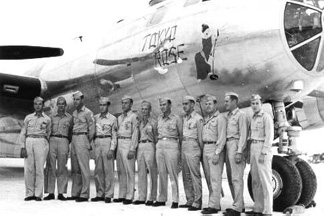 |
||||||||||||||||
|
A/C Captain Steakley and his crew. |
||||||||||||||||
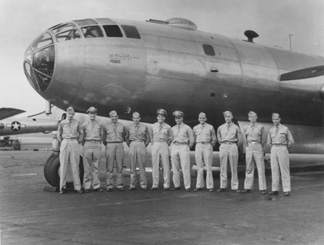 |
||||||||||||||||
|
Okinawa a month later. |
||||||||||||||||
| My first mission on November 24th coincided with the first B-29 raid by the B-29s from Saipan. It was most memorable. Two F-13As were scheduled for take of at 6AM with the primary mission of dropping chaff from our planes southeast of Tokyo to decoy the Japanese fighters to us. We were at 33,000 feet, a couple thousand feet above most Japanese fighters. The bombers were scheduled to start their takeoffs at 6:30AM. There was a single runway at Isely at the time with a parallel runway under construction. The runway had a hump in the middle of the runway and with tower radio silence I taxied to the end of the runway with Walt Voris behind me to follow my takeoff. |
||||||||||||||||
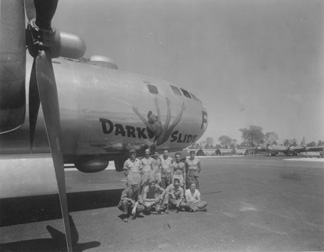 |
||||||||||||||||
|
with a selection of his crewmembers. |
||||||||||||||||
| My squadron commander LTC Pat McCarthy had bumped my copilot and was in the copilot seat. At 6AM, started to roll and after getting over the runway rise, I could see 6x6 trucks crossing the runway about 2/3rds of the way down the length of the runway. The trucks were hauling coral to the parallel runway under construction. Then, one of the truck drivers stopped right in the middle of the runway. It was to late to abort without clobbering us and the truck. I spun the turbo dial to max power (ten) and while still about twenty miles under normal take off speed, stalled the airplane over the truck. The plane settled back down on the coral overrun and we headed over the cliff where we were about 300 feet to the water enabled us to gain airspeed, retract the landing gear. I asked my C.O. to milk up the flaps, (meaning bring the flaps up a little at the time) but he dumped them all at once. My CFC (central fire control) gunner called, “Captain, we’re kicking up a wake with the props.” indicating that we had settled down very close to the water. We had swallowed a valve on the #3 engine while at max power and the engine ran rough when the fuel mixture was leaned out for cruising but ran smooth when in full rich mixture. We continued the mission flying at 1,000 feet until time to climb as we approached Japan. We climbed to altitude where we donned oxygen masks and depressurized the plane. This was necessary because the chaff dispensing chutes were located in the un-pressurized compartment in the rear of the plane. After the chaff was dispensed, we re-pressurized and began to see many fighters heading for us but stalling out a thousand or so feet below us. Our two chaff dispensing planes had successfully attracted their fighters while the bombers entered Japan southwest of Tokyo shortly thereafter to hit their target, the Mitsubishi Aircraft Plant, west of Tokyo. The bombers had no fighter opposition until about the time they reached their target. We in turn continued on north of Tokyo, took pictures of other future targets and returned to Saipan. The #3 engine ran rough but still provided enough power so that we did not have to feather it. |
||||||||||||||||
|
Page 1 of 3 Pages, Chapter 7 — Go to Page 2 Or go to Chapter 1 — 2 — 3 — 4 — 5 — 6 — 7 — 8 — 9 — 10 — 11 Cover Page — Introduction — Table of Contents Or you may go to Home - Contact Us - Cold War Hist. - 91st SRS Hist. - Stardust 40 Mission Story |
||||||||||||||||